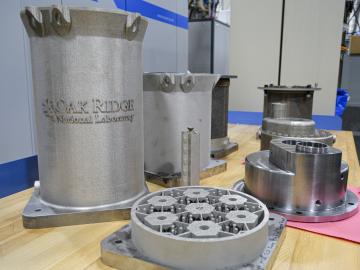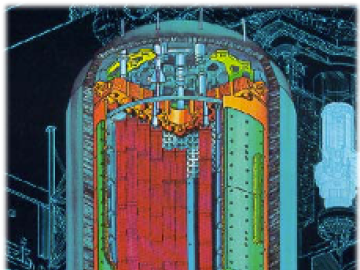
Filter News
Area of Research
- (-) Nuclear Science and Technology (17)
- (-) Supercomputing (87)
- Advanced Manufacturing (7)
- Biology and Environment (79)
- Biology and Soft Matter (1)
- Building Technologies (2)
- Computational Biology (1)
- Computational Engineering (2)
- Computer Science (9)
- Electricity and Smart Grid (3)
- Energy Science (171)
- Energy Sciences (1)
- Functional Materials for Energy (1)
- Fusion and Fission (14)
- Fusion Energy (8)
- Isotope Development and Production (1)
- Isotopes (5)
- Materials (44)
- Materials for Computing (8)
- Mathematics (1)
- National Security (25)
- Neutron Science (19)
- Nuclear Systems Modeling, Simulation and Validation (1)
- Quantum information Science (2)
- Sensors and Controls (1)
- Transportation Systems (2)
News Topics
- (-) Advanced Reactors (12)
- (-) Artificial Intelligence (37)
- (-) Exascale Computing (26)
- (-) Grid (5)
- (-) Space Exploration (8)
- (-) Transportation (6)
- 3-D Printing/Advanced Manufacturing (8)
- Big Data (22)
- Bioenergy (9)
- Biology (11)
- Biomedical (19)
- Biotechnology (2)
- Buildings (4)
- Chemical Sciences (5)
- Computer Science (97)
- Coronavirus (14)
- Critical Materials (3)
- Cybersecurity (9)
- Energy Storage (8)
- Environment (23)
- Frontier (32)
- Fusion (9)
- High-Performance Computing (43)
- Isotopes (7)
- Machine Learning (15)
- Materials (15)
- Materials Science (19)
- Mathematics (2)
- Microscopy (7)
- Molten Salt (5)
- Nanotechnology (11)
- National Security (8)
- Neutron Science (17)
- Nuclear Energy (39)
- Partnerships (1)
- Physics (10)
- Polymers (2)
- Quantum Computing (20)
- Quantum Science (25)
- Security (6)
- Simulation (16)
- Software (1)
- Summit (43)
Media Contacts

For the second year in a row, a team from the Department of Energy’s Oak Ridge and Los Alamos national laboratories led a demonstration hosted by EPB, a community-based utility and telecommunications company serving Chattanooga, Tennessee.

Researchers at the Department of Energy’s Oak Ridge National Laboratory are refining their design of a 3D-printed nuclear reactor core, scaling up the additive manufacturing process necessary to build it, and developing methods

In the 1960s, Oak Ridge National Laboratory's four-year Molten Salt Reactor Experiment tested the viability of liquid fuel reactors for commercial power generation. Results from that historic experiment recently became the basis for the first-ever molten salt reactor benchmark.

In the race to identify solutions to the COVID-19 pandemic, researchers at the Department of Energy’s Oak Ridge National Laboratory are joining the fight by applying expertise in computational science, advanced manufacturing, data science and neutron science.

A software package, 10 years in the making, that can predict the behavior of nuclear reactors’ cores with stunning accuracy has been licensed commercially for the first time.

As the second-leading cause of death in the United States, cancer is a public health crisis that afflicts nearly one in two people during their lifetime.

The prospect of simulating a fusion plasma is a step closer to reality thanks to a new computational tool developed by scientists in fusion physics, computer science and mathematics at ORNL.

Scientists at have experimentally demonstrated a novel cryogenic, or low temperature, memory cell circuit design based on coupled arrays of Josephson junctions, a technology that may be faster and more energy efficient than existing memory devices.

Researchers across the scientific spectrum crave data, as it is essential to understanding the natural world and, by extension, accelerating scientific progress.

For nearly three decades, scientists and engineers across the globe have worked on the Square Kilometre Array (SKA), a project focused on designing and building the world’s largest radio telescope. Although the SKA will collect enormous amounts of precise astronomical data in record time, scientific breakthroughs will only be possible with systems able to efficiently process that data.


